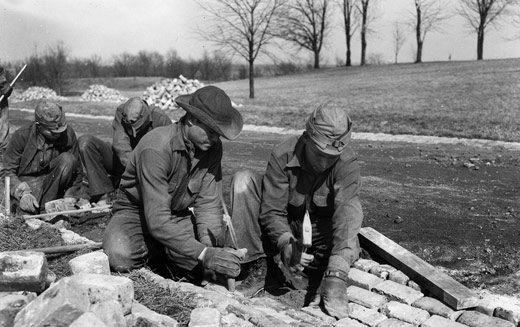
President Obama has said that he will issue executive orders where Congress will not act. We can rest assured that Congress will do nothing to help American Indians in the jobs category; hence, executive orders are a must.
I must preface this column with the fact that nothing has substantially changed in Indian Country with the Obama presidency. Longtime, distinguished Indian activist, John Trudell, recently expressed the sentiments of many Natives when in the press he said, “When you look at the sovereignty, the economics, the cultural well-being of the Native people [Obama] hasn’t done one thing. He’s just like every other U.S. president. I think a lot of Native people are just glad to be acknowledged. You look at the time Obama has been in office, and the teen suicide rates are [still] out of control, the poverty is out of control.”
In regard to Native American unemployment I had written, in the Native press, what Obama could do early on in his presidency based on programs initiated during the Great Depression of the 1930s. During that era thousands of Native Americans were employed on reservations under a separate division of the Civilian Conservation Corps (CCC) in soil erosion control, forestation improvement, restoration of grazing lands and other land-based conservation programs. American Indians were employed in developing natural resources on reservations across the country. This division of the CCC was called the Indian Emergency Conservation Work (IECW) program or the Indian Division of the CCC, popularly abbreviated as the ID-CCC.
The CCC itself was established as an agency to provide employment and training to young men and war veterans, and separately to a limited extent to young American Indian men who could not find work otherwise during the Great Depression. The CCC included public works projects and also conservation and the development of natural resources, which is where reservations were involved. Ironically, because of these programs, for many Indian peoples, the Great Depression was a time of comparative plenty due to the CCC. Participants received food, clothing and a base monthly wage.
During this time officials in the Bureau of Indian Affairs (BIA) became very excited over having an Indian component in the then newly formed CCC. These authorities knew that the reservations were in dire need of soil erosion control, forestation improvements, restoration of grazing lands and other CCC-type projects that could provide employment to Native Americans. Further, BIA leaders strongly believed that Indians should have their own organization apart from the regular CCC. President Roosevelt heartily approved it. In the first program sign-up period over 14,000 Native Americans were employed in just six months’ time.
Since the massive unemployment of the Depression severely limited the possibility of virtually any off-reservation work, the main focus was to provide assistance to reservation populations. The goal was to conserve and improve reservation land so more Native Americans could make a living from ranching and farming.
The original IECW projects were based in cities located near reservations or in heavily populated Native areas such as Muskogee, Okla.; Minneapolis, Minn.; Phoenix, Ariz.; Spokane, Wash.; and Albuquerque, N.M. These district offices corresponded to major geographic regions with the largest American Indian populations. By July 1933, 56 reservations were involved.
Worked on bridges, roads and clinics
Indian men worked on bridges, roads, clinics, shelters and other public works on or near their reservations. The CCC often provided the only work on the reservations. A huge drawback, and bias, was that no women were allowed to participate. Enrollees had to be males between the ages of 17 and 35. For example, in 1933 nearly half the males in households on the Sioux reservations in South Dakota were employed by the IECW. With grants from the Works Progress Administration (WPA, renamed in 1939 as the Work Projects Administration) the Indian Division constructed schools and maintained extensive road systems in and around numerous reservations.
The objective also was to reduce erosion and improve the quality of Native land. Squads of enrollees built diversified types of dams on creeks and other waterways, and sowed grass and planted groves of trees. In many areas they actually built new roads. The Division also trained participants in gardening, livestock raising, safety issues and many academic subjects. The IECW differed from other CCC activities in that it also trained enrollees in carpentry, truck driving, radio operation, and to be mechanics, surveyors and technicians. During the program’s existence over 85,000 American Indians from over 70 reservations were enrolled. The steady income produced an improved sense of morale and uplifted the living standards of the enrollees and their families.
The Indian Division produced awesome results. To cite only a few, reservation forests had 9,739 miles of truck trails laid out; 1,351,870 acres put under pest control; and countless fire lookout towers constructed. Indian grazing and farm lands had 263,129 acres subject to poisonous weed eradication, and 1,792 large dams and reservoirs were constructed. Reportedly, at no time before or since have reservation forests and lands been in better condition than in 1942, when the program ended.
Also, large tracts of grazing land benefited from the IECW. Fencing out white ranchers’ strays, water development and reseeding helped to raise sales of Indian cattle from $263,095 in 1933 to a whopping $3,126,326 in 1939. This likewise led to the acquisition of more cattle, discouraged leasing to white ranchers, and encouraged loans for foundation stock and organization of Indian cattlemen’s associations. Such were the benefits of the IECW of the 1930s.
The singular importance of this program was that it worked in terms of providing employment to reservations that had been bereft of jobs for generations. There was a huge diversity of work performed by enrollees. To be more specific, program reports list 126 types of projects, ranging from improvement of grazing lands in Arizona to the operation of fish hatcheries in Wisconsin. CCC field inspectors worked to start projects based on geographic conditions and distinct reservation needs with the goal of affording Native Americans a decent livable wage. Hence, the IECW in the Pacific Northwest and Great Lakes region focused largely on forestation. Native enrollees commonly built trails, cut forest lanes and constructed lookout towers to protect Indian lumber resources from fires. Also, large areas of timber were covered by crews who combated blister disease and pine beetles. Just as necessary were the miles of telephone lines strung by enrollees between lookouts and headquarters so reservation fires could be quickly detected and extinguished.
In the Southwest, the Northern Great Plains and the Great Basin of Utah and Nevada, the IECW concentrated on improving reservation grazing lands. Native enrollees controlled rodent populations, drilled wells, reseeded range lands, developed existing springs and built thousands of earth and masonry dams. In particular, in the Southwest, to improve grazing, enrollees were able to control wild mustangs on livestock lands. This provided increased rangeland for cattle, goats and sheep.
In tandem with range advancement was the control of soil erosion. The very dams that stored water for livestock also reduced erosion and made possible reseeded range that was resistant to the ravages of drought and wind. Oklahoma enrollees built check dams and terraces to stop topsoil loss from water runoff and set some 200 miles of shelterbelts in the western sector of the state to prevent wind erosion. The timber of the shelterbelts grew lush and tall, presenting mute testimony against the notion that trees could not flourish on the Great Plains.
Also, the IECW offered educational benefits to Native participants.
The point to be made is that Native Americans saw more employment opportunities during the Depression than before or after that economic collapse. Looking forward to today, a permanent program should be in place to provide income for the economically strapped reservations.
President Obama must see the urgency for jobs. He has the constitutional power by executive order to create tens of thousands of jobs for Native Americans and for the rest of the country. He has the power in his hands; he must use it!
But he will not act without mass pressure, and obviously it would help if he had a cooperative Congress. There are only two years left to get him to do what we would like him to have done in his first 100 days in office.
Photo: Civilian Conservation Corps – NARA – 195832 Public Domain. CCC workers constructing a road, 1933.











